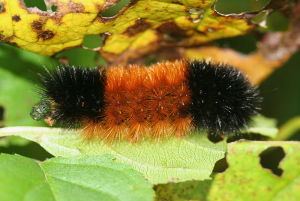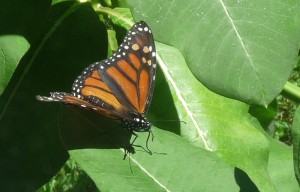There are many amazing things about nature that are both observable and explainable. One that probably isn’t, though, involves organisms like oak trees and woodpeckers and spiders forecasting, many months ahead of time, the intensity of a coming winter. For this to be observable and explainable one would have to assume that these species (and many more for that matter) somehow perceive clues in the environment that we lumbering (but sentient) bipeds do not. Take the wooly bear caterpillar for example: it is alleged that they take on a darker color if the coming winter is going to be more severe. What would be the trigger for that color change? And, maybe even more significantly, why would they do that? Even if they could perceive some clues that the coming winter was going to be cold and snowy, what advantage would it be to the caterpillar (or to the overwintering pupa of that caterpillar, actually) to have an abundance of black body hairs? There would have to be some selective advantage or the character would never have evolved!
Ten years ago I had an ecology student who wanted to study wooly bear caterpillars. His idea was to collect as many wooly bears as possible and see if their “message” was consistent across the population. He collected one hundred wooly bears over a four week period and determined the size of their black bands. He found that their winter forecast was, at best, random. The early collections seemed to lean toward a mild winter (narrower black bands) and the later collections seemed to lean toward a more severe winter (broader black bands) but the variation in each collection almost completely obscured their overall trends.
We determined two things from this wooly bear study: 1. As wooly bear caterpillars age and grow, they develop more black hairs, and 2. Selective observation of the wooly bear population (only observing a very small number of individuals at any one time) could lead you to conclude whatever you might want about the coming winter.
Selective observation may be the operational idea here!
There are a number of winter-predictive observations that involve things happening “earlier” than usual. There is the “early” departure of geese and ducks, the “early” migration of the monarch butterflies, and the “early” hiving up of honey bees. The quality of these observations, of course, depends upon prior knowledge of exactly when these events have happened in the past and, therefore, should be happening in the present. This data is not readily accessible.
There are also a number of observations of things being more abundant or more developed than usual. An “excess” abundance of acorns, “thicker than usual” corn husks, “more abundant than usual” late summer frogs, “thicker hair than usual” on the back of a cow’s neck, more mice (or crickets) than “usual” entering your house, and “larger than usual” spider webs being spun out in the garden. Again, the data base of “normal” or “usual” for all of these events just does not, as far as I know, exist, but if you happen to see a large spider web, or happen to hear lots of mice in your kitchen, then you might easily jump to whatever conclusions you want and then feel the need to start stocking up on canned foods!
Squirrels are also used as winter-indicators. They “frantically” gather acorns in anticipation of a coming hard winter. I have never seen a squirrel gathering acorns (or chestnuts, or hickory nuts) in anything other than a “frantic” manner. A leisurely working squirrel is very likely to become a quick lunch for a red-tailed hawk!
There were a couple of nature’s “winter predictors” that might have some validity, though. The “early arrival of snowy owls” might be indicative of the early movement of cold, polar air masses down to lower latitudes. “Foggier than usual” August and a prevalence of autumnal halos around the moon might also indicate the early arrival of colder, northern air masses which foreshadow a longer, more intense winter.
Or not.
My favorite winter-intensity myth stated that when two woodpeckers share a tree the winter will be severe. I am not sure if it matters what kind of woodpeckers might be co-habitating, but I am keeping my eyes open for that one!


